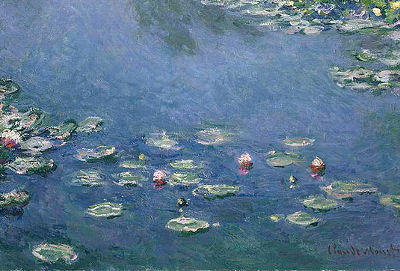 |
Art
: See Monet in Paris |
| About-France.com - a thematic guide to France - | |

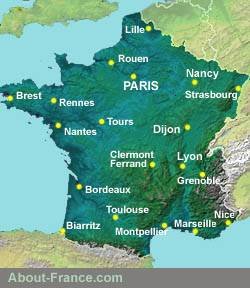 |
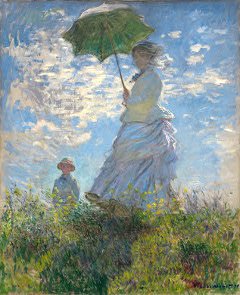 |
In this picture, Monet is playing with light and shadow.... Where exactly is the sun in this painting? It can't be behind Madame Monet, nor behind the parasol, otherwise the shadows would come straight at us.....
| Related
pages on About-France.com |
After the exhibition - Monet in Paris: 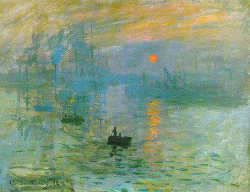 For
visitors who missed the big exhibition at the Grand Palais, there is
still plenty of opportunity to see works by the greatest of the
Impressionists at other locations in Paris. For
visitors who missed the big exhibition at the Grand Palais, there is
still plenty of opportunity to see works by the greatest of the
Impressionists at other locations in Paris.Paris's Musée Marmottan Monet (address and opening times) contains the world's largest collection of Monets under a single roof; the Musée has a permanent display including a substantial collection of works not just by Monet, but by other major Impressionist painters, including Degas, Manet, Renoir, Sisley, Pissarro, Gauguin, and Berthe Morisot. Not far from the Eiffel tower, on the banks of the Seine, the Musée d'Orsay (address and opening times) contains France's greatest collection of Impressionist art, with notable works by all the Impressionists, including Renoir, Manet, Monet, Degas, Van Gogh, Sisley, Pissaro and others. Some of the works that were on display in the Monet exhibition at the Grand Palais will be up on view again in the Musée d'Orsay where they belong. In addition to these two locations, there is the Musée de l'Orangerie (address and opening times), in the gardens of the Tuileries, which is home to a fine and huge set of Monet water lilies, as well as works by Renoir, Cézanne, Rousseau, Matisse, Picasso, Utrillo and others. Finally, not to be forgotten is the free Musée des Beaux Arts de la ville de Paris, the Paris city fine art museum, located in the Petit Palais just round the corner from the Grand Palais, which has a section devoted to 19th century art, including works by Monet, Sisley and Pissarro. Monet the father of modern art 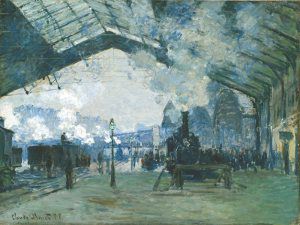 Monet has been described as the father of modern
art. France in the
early nineteenth century was the undisputed leader in world art; but as
leaders, its artists were constantly on the search for new paths, new
ways to portray a changing society in ways that would reflect the
spirit of the age. At first it was the Neoclacissists - the followers
of the great classical school of painting embodied by artists like
Ingres and David - aginst the Romantics, led by Delacroix; but for
others, both these schools of art were too staid, too steeped in
tradition. Monet has been described as the father of modern
art. France in the
early nineteenth century was the undisputed leader in world art; but as
leaders, its artists were constantly on the search for new paths, new
ways to portray a changing society in ways that would reflect the
spirit of the age. At first it was the Neoclacissists - the followers
of the great classical school of painting embodied by artists like
Ingres and David - aginst the Romantics, led by Delacroix; but for
others, both these schools of art were too staid, too steeped in
tradition.Small groups of artists in France (as in England) took to experimenting with other methods of painting. The painters of the "Barbizon" school developed outdoor landscape painting, inspired initially by the English landscape painter John Constable who exhibited in Paris in 1824; other artists like Gustave Courbet went down the road of social realism; but it was Monet and the Impressionists, following on in their footsteps, who did most to deconstruct the rules of art, and it was Monet who provided the name by which he and his fellow artists have come to be known. The Impressionists were resolutely modern for their time, seizing the opportunity to paint not just landscapes and people, but all aspects of the changing society in which they lived. Monet was one of the first artists to find inspiration in street scenes and railway stations (above: one of his paintings of the Gare Saint Lazare in Paris). Monet and Impressionism The name "Impressionism" was derived from a painting of the port of Le Havre exhibited by Monet at an exhibition of avant-garde artists in 1874 , and entitled "Impression soleil levant" - or in English "Impression, sunrise" (visible at the Musée Marmottan, see below). Writing in the Charivari magazine, art critic Louis Leroy used the word from the title of Monet's painting to ridicule this unconventional type of art, calling the group of artists "Impressionists"; and the name stuck. It would be wrong to imagine that the Impressionists were a cohesive group of artists all working together: they were not. Edouard Manet, one of the elder Impressionists, even objected for a long time to being bracketed together in artistic terms with Monet and Renoir, and while he was friends with both these artists, and with other Impressionist painters, refused to take part in the Impressionist exhibitions organised in the decade after 1874. The Impressionists were not a united fraternity, and they were not initially hailed as great painters – rather the reverse. For much of their lives, apart from Degas and Manet who came from wealthy families, most Impressionist painters lived in relative poverty and had difficulty selling their painting. Yet in an age when "avant-garde" was a term of disapproval, the Impressionists were championed by a few forward-looking dealers, and in particular by Durand-Ruel who eventually found a market for Impressionist art outside France, notably in London and New York. In due course the French art establishment took note, and thus by the end of the nineteenth century these previously derided artists were starting to gain recognition even in official circles. In his later years, Monet was actually hailed as one of France's great artists, and some of the waterlily paintings were painted on commission for the French government. Locations, prices : Musée Marmottan: 2 rue Boilly, Paris 16. Metro line 9, station La Muette. Open 11 a.m. - 6 p.m. Closed on Mondays. Entrance 9 €. Reduced rate: 5 € Musée d'Orsay: rue de Lille, Paris 7. On the other bank of the Seine, almost opposite the Louvre. Metro solférino. Open 9.30 am to 6 pm Tuesday to Sunday. Late opening to 9.45 pm on Thursdays. Standard entrance: 8 €. Musée de l'Orangerie: Jardin des tuileries Place de la Concorde, Paris 1. Metro Concorde. Open 9 am - 6 pm except Tuesdays (closed). Entrance: € 7.50 Combined ticket Orangerie / Orsay Museums: 13 € (Valid 4 days) Petit Palais - Musée des Beaux Arts de la ville de Paris. Avenue Winston Churchill, Paris 8. Metro Champs Elysées. Entrance free. Warning - long delays:
There are generally long queues to get into the main museums, for those who have to purchase a ticket at the entrance. Avoid the queues buy buying a pass in advance SKIP THE LINES... Entrance to most Paris museums including the Louvre is included in the Paris Pass. Get 10% off passes with About-France.com. Quote reference ABOUTFRA. Book now Map of selected hotels in Paris near the main monuments (This map only features hotels that are well recommended by user reviews) Copyright ©
About-France.com 2016
|
**  The Paris Pass includes access to the Louvre and the Orsay Museum 10% off Paris passes with About-France.com, using the code ABOUTFRA *** |
